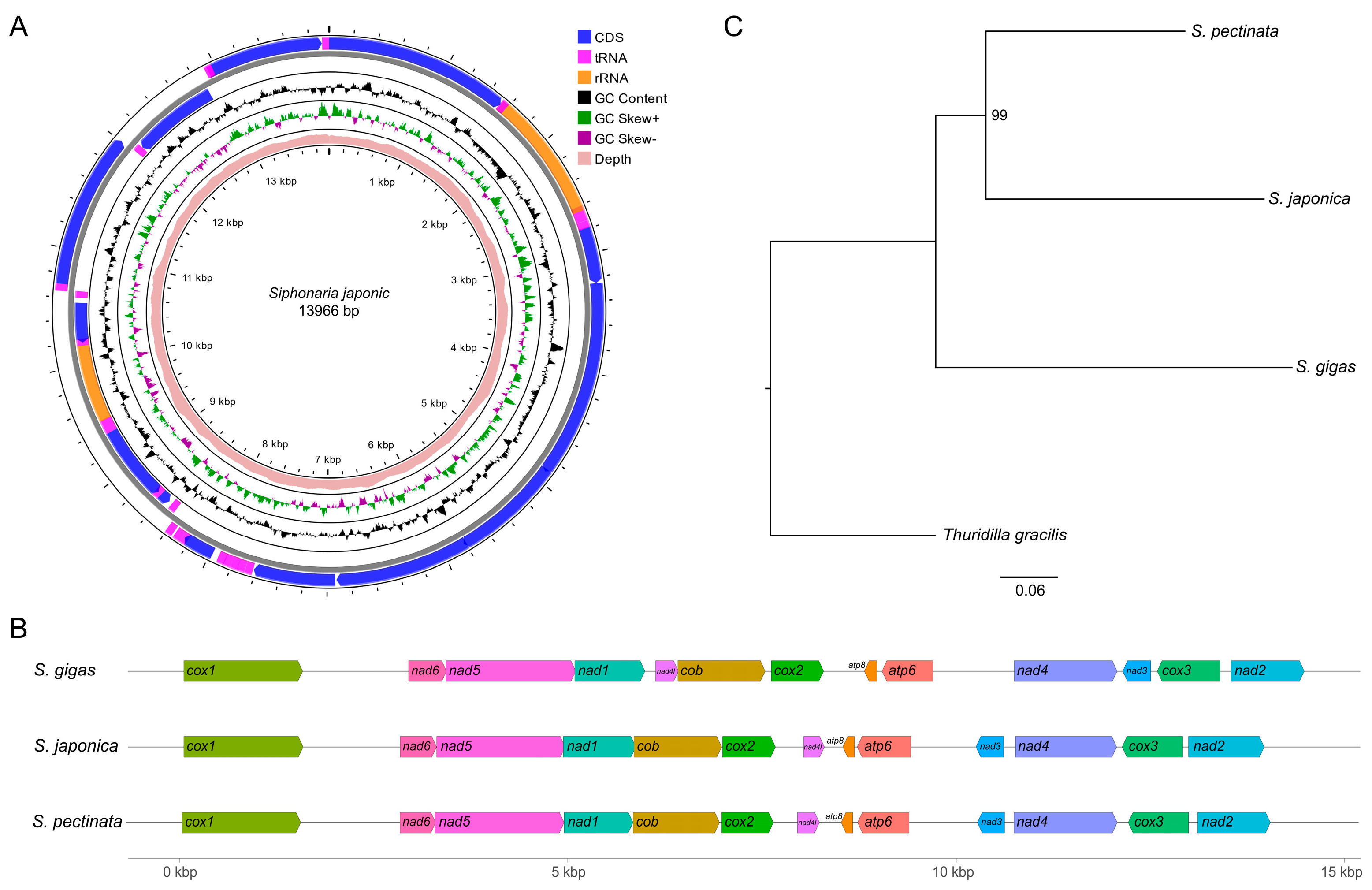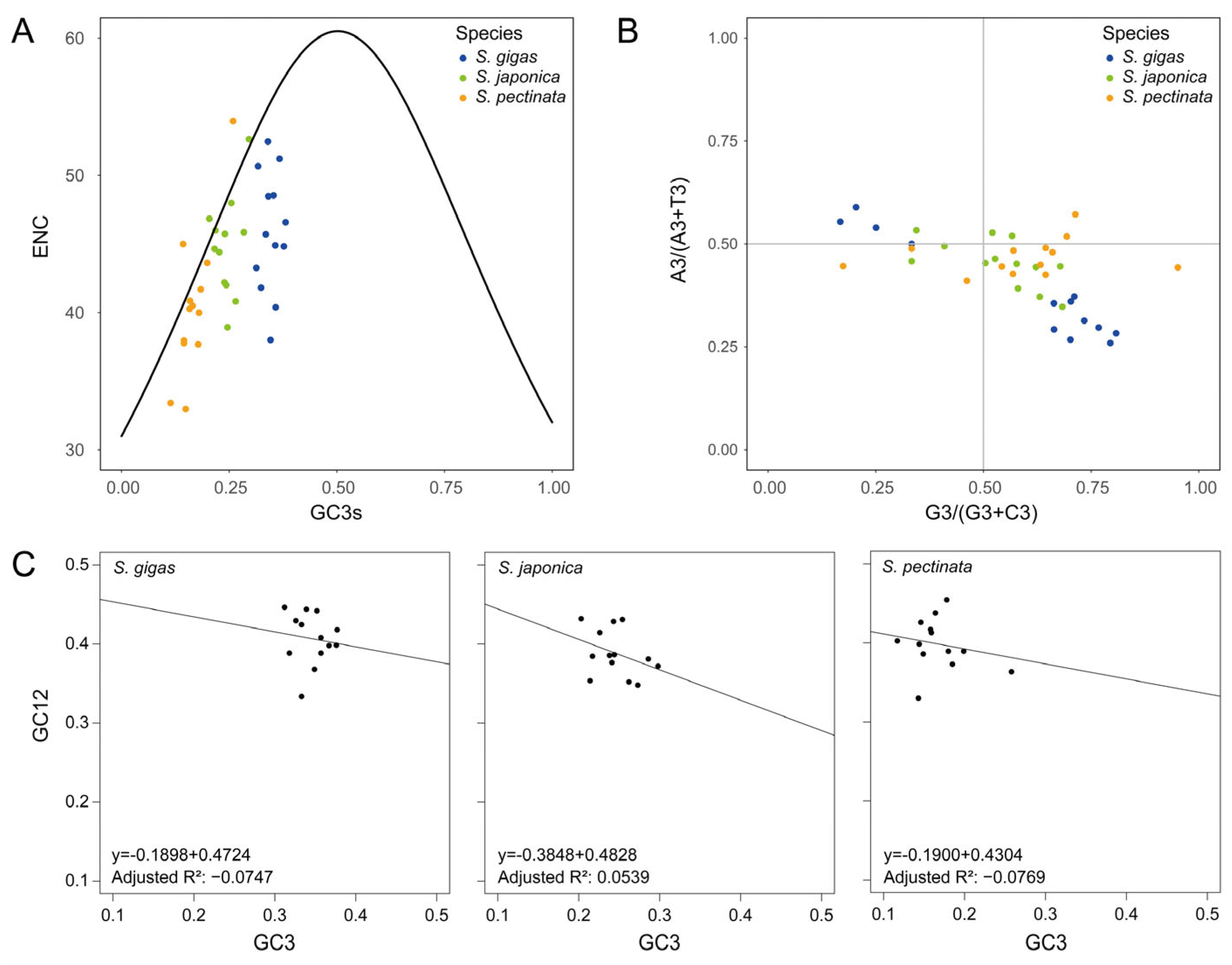Codon Usage Bias in Mitochondrial Genomes Across Three Species of Siphonaria (Mollusca: Gastropoda)
Abstract
1. Introduction
2. Materials and Methods
2.1. Materials Studied
2.2. Mitochondrial Genome Sequencing
2.3. Phylogenetic Analysis
2.4. Codon Usage Bias Analysis
3. Results
3.1. Mitochondrial Genome of S. japonica
3.2. Phylogeny of Siphonaria Species
3.3. Codon Usage Bias of Siphonaria Mitochondrial PCGs
4. Discussion
5. Conclusions
Author Contributions
Funding
Institutional Review Board Statement
Informed Consent Statement
Data Availability Statement
Conflicts of Interest
References
- Zang, G.; Wang, J.; Ma, P.; Li, C.; Chen, Y.; Tang, Z.; Wang, H. Identifications of common species and descriptions of two new species of Siphonaria (Mollusca: Gastropoda) in China. Biology 2025, 14, 103. [Google Scholar] [CrossRef] [PubMed]
- Kim, Y.; Park, J.; Hwang, U.W.; Park, J.K. Taxonomic review of Korean Siphonaria species (Mollusca, Gastropoda, Siphonariidae). Biodivers. Data J. 2025, 13, e139388. [Google Scholar] [CrossRef] [PubMed]
- Ossenbrügger, H.; Neiber, M.T.; Hausdorf, B. Diversity of Siphonaria Sowerby I, 1823 (Gastropoda, Siphonariidae) in the Seychelles Bank and beyond. Zool. Scr. 2022, 52, 31–45. [Google Scholar] [CrossRef]
- Dayrat, B.; Goulding, T.C.; White, T.R. Diversity of Indo-West Pacific Siphonaria (Mollusca: Gastropoda: Euthyneura). Zootaxa 2014, 3779, 246–276. [Google Scholar] [CrossRef]
- Giribet, G.; Kawauchi, G.Y. How many species of Siphonaria pectinata (Gastropoda: Heterobranchia) are there? J. Molluscan Stud. 2016, 82, 137–143. [Google Scholar] [CrossRef][Green Version]
- Wang, H.; Geng, S.; Liu, S.; Li, Z.; Cameron, S.; Lei, T.; Xu, W.; Liu, Q.; Zuo, S.; Omongo, C.A.; et al. Unraveling the cryptic Bemisia tabaci species complex: Global phylogenomic analysis reveals evolutionary relationships and biogeographic patterns. Insect Sci. 2025. [Google Scholar] [CrossRef]
- White, T.R.; Conrad, M.M.; Tseng, R.; Balayan, S.; Golding, R.; de Frias Martins, A.M.; Dayrat, B.A. Ten new complete mitochondrial genomes of pulmonates (Mollusca: Gastropoda) and their impact on phylogenetic relationships. BMC Ecol. Evol. 2011, 11, 295. [Google Scholar] [CrossRef]
- Grande, C.; Templado, J.; Cervera, J.L.; Zardoya, R. Phylogenetic relationships among Opisthobranchia (Mollusca: Gastropoda) based on mitochondrial cox 1, trnV, and rrnL genes. Mol. Phylogenet. Evol. 2004, 33, 378–388. [Google Scholar] [CrossRef]
- Güller, M.; Zelaya, D.G.; Ituarte, C. How many Siphonaria species (Gastropoda: Euthyneura) live in southern South America? J. Molluscan Stud. 2016, 82, 80–96. [Google Scholar] [CrossRef]
- Lei, T.; Zheng, X.; Song, C.; Jin, H.; Chen, L.; Qi, X. Limited variation in codon usage across mitochondrial genomes of non-biting midges (Diptera: Chironomidae). Insects 2024, 15, 752. [Google Scholar] [CrossRef]
- Biro, J.C. Does codon bias have an evolutionary origin? Theor. Biol. Med. Model. 2008, 5, 16. [Google Scholar] [CrossRef] [PubMed]
- Lei, T.; Luo, N.; Song, C.; Yu, J.; Zhou, Y.; Qi, X.; Liu, Y. Comparative genomics reveals three genetic groups of the whitefly obligate endosymbiont Candidatus Portiera aleyrodidarum. Insects 2023, 14, 888. [Google Scholar] [CrossRef]
- Liu, Y. A code within the genetic code: Codon usage regulates co-translational protein folding. Cell Commun. Signal. 2020, 18, 145. [Google Scholar] [CrossRef]
- Quax, T.E.F.; Claassens, N.J.; Söll, D.; van der Oost, J. Codon bias as a means to fine-tune gene expression. Mol. Cell 2015, 59, 149–161. [Google Scholar] [CrossRef]
- Behura, S.K.; Severson, D.W. Codon usage bias: Causative factors, quantification methods and genome-wide patterns: With emphasis on insect genomes. Biol. Rev. 2012, 88, 49–61. [Google Scholar] [CrossRef]
- Das, S.; Paul, S.; Dutta, C. Synonymous codon usage in adenoviruses: Influence of mutation, selection and protein hydropathy. Virus Res. 2006, 117, 227–236. [Google Scholar] [CrossRef]
- Cao, J.K.; Lei, T.; Gu, J.J.; Song, C.; Qi, X. Codon bias analysis of the mitochondrial genome reveals natural selection in the nonbiting midge Microtendipes umbrosus Freeman, 1955 (Diptera: Chironomidae). Pan-Pac. Entomol. 2023, 99, 217–225. [Google Scholar] [CrossRef]
- Chen, S. Ultrafast one-pass FASTQ data preprocessing, quality control, and deduplication using fastp. iMeta 2023, 2, e107. [Google Scholar] [CrossRef]
- Dierckxsens, N.; Mardulyn, P.; Smits, G. NOVOPlasty: De novo assembly of organelle genomes from whole genome data. Nucleic Acids Res. 2016, 45, e18. [Google Scholar] [CrossRef]
- Danecek, P.; Bonfield, J.K.; Liddle, J.; Marshall, J.; Ohan, V.; Pollard, M.O.; Whitwham, A.; Keane, T.; McCarthy, S.A.; Davies, R.M.; et al. Twelve years of SAMtools and BCFtools. GigaScience 2021, 10, giab008. [Google Scholar] [CrossRef]
- Donath, A.; Jühling, F.; Al-Arab, M.; Bernhart, S.H.; Reinhardt, F.; Stadler, P.F.; Middendorf, M.; Bernt, M. Improved annotation of protein-coding genes boundaries in metazoan mitochondrial genomes. Nucleic Acids Res. 2019, 47, 10543–10552. [Google Scholar] [CrossRef] [PubMed]
- Minh, B.Q.; Schmidt, H.A.; Chernomor, O.; Schrempf, D.; Woodhams, M.D.; von Haeseler, A.; Lanfear, R. Corrigendum to: IQ-TREE 2: New models and efficient methods for phylogenetic inference in the genomic era. Mol. Biol. Evol. 2020, 37, 2461. [Google Scholar] [CrossRef] [PubMed]
- Vaidya, G.; Lohman, D.J.; Meier, R. SequenceMatrix: Concatenation software for the fast assembly of multi-gene datasets with character set and codon information. Cladistics 2011, 27, 171–180. [Google Scholar] [CrossRef] [PubMed]
- Sharp, P.M.; Li, W.H. An evolutionary perspective on synonymous codon usage in unicellular organisms. J. Mol. Evol. 1986, 24, 28–38. [Google Scholar] [CrossRef]
- Kumar, S.; Stecher, G.; Li, M.; Knyaz, C.; Tamura, K. MEGA X: Molecular evolutionary genetics analysis across computing platforms. Mol. Biol. Evol. 2018, 35, 1547–1549. [Google Scholar] [CrossRef]
- Wright, F. The ‘effective number of codons’ used in a gene. Gene 1990, 87, 23–29. [Google Scholar] [CrossRef]
- Sueoka, N. Intrastrand parity rules of DNA base composition and usage biases of synonymous codons. J. Mol. Evol. 1995, 40, 318–325. [Google Scholar] [CrossRef]
- Sueoka, N. Directional mutation pressure and neutral molecular evolution. Proc. Natl. Acad. Sci. USA 1988, 85, 2653–2657. [Google Scholar] [CrossRef]
- Ling, L.; Zhang, S.; Yang, T. Analysis of codon usage bias in chloroplast genomes of Dryas octopetala var. asiatica (Rosaceae). Genes 2024, 15, 899. [Google Scholar] [CrossRef]
- Zhao, R.; Li, H.; Wu, G.; Wang, Y.F. Codon usage bias analysis in the mitochondrial genomes of five Rhingia Scopoli (Diptera, Syrphidae, Eristalinae) species. Gene 2024, 917, 148466. [Google Scholar] [CrossRef]
- Wang, F.; Zhang, N.; Zhao, C.; Song, Z.; Xin, C. Codon usage bias analysis of mitochondrial protein-coding genes in 12 species of Candida. J. Genet. 2023, 102, 36. [Google Scholar] [CrossRef] [PubMed]
- Novoa, E.M.; Ribas de Pouplana, L. Speeding with control: Codon usage, tRNAs, and ribosomes. Trends Genet. 2012, 28, 574–581. [Google Scholar] [CrossRef] [PubMed]
- Drummond, A.; Shah, P.; Gilchrist, M.A. Effect of correlated tRNA abundances on translation errors and evolution of codon usage bias. PLoS Genet. 2010, 6, e1001128. [Google Scholar] [CrossRef]
- Wu, P.; Xiao, W.; Luo, Y.; Xiong, Z.; Chen, X.; He, J.; Sha, A.; Gui, M.; Li, Q. Comprehensive analysis of codon bias in 13 Ganoderma mitochondrial genomes. Front. Microbiol. 2023, 14, 1170790. [Google Scholar] [CrossRef]
- Shi, S.L.; Jiang, Y.R.; Yang, R.S.; Wang, Y.; Qin, L. Codon usage in Alphabaculovirus and Betabaculovirus hosted by the same insect species is weak, selection dominated and exhibits no more similar patterns than expected. Infect. Genet. Evol. 2016, 44, 412–417. [Google Scholar] [CrossRef]
- Mazumder, G.A.; Uddin, A.; Chakraborty, S. Expression levels and codon usage patterns in nuclear genes of the filarial nematode Wucheraria bancrofti and the blood fluke Schistosoma haematobium. J. Helminthol. 2016, 91, 72–79. [Google Scholar] [CrossRef]
- Chakraborty, S.; Uddin, A.; Mazumder, T.H.; Choudhury, M.N.; Malakar, A.K.; Paul, P.; Halder, B.; Deka, H.; Mazumder, G.A.; Barbhuiya, R.A.; et al. Codon usage and expression level of human mitochondrial 13 protein coding genes across six continents. Mitochondrion 2018, 42, 64–76. [Google Scholar] [CrossRef]
- Deb, B.; Uddin, A.; Mazumder, G.A.; Chakraborty, S. Analysis of codon usage pattern of mitochondrial protein-coding genes in different hookworms. Mol. Biochem. Parasitol. 2018, 219, 24–32. [Google Scholar] [CrossRef]
- Zhou, M.; Li, X. Analysis of synonymous codon usage patterns in different plant mitochondrial genomes. Mol. Biol. Rep. 2008, 36, 2039–2046. [Google Scholar] [CrossRef]



| (A) S. gigas | ||||
| GC1 | GC2 | GC3 | GCall | |
| GC2 | 0.23 | |||
| GC3 | 0.06 | −0.30 | ||
| GCall | 0.87 *** | 0.57 * | 0.21 | |
| ENC | 0.11 | −0.46 | −0.04 | −0.14 |
| (B) S. japonica | ||||
| GC1 | GC2 | GC3 | GCall | |
| GC2 | 0.07 | |||
| GC3 | −0.35 | 0.01 | ||
| GCall | 0.73 ** | 0.56 | 0.20 | |
| ENC | −0.11 | 0.39 | 0.30 | 0.24 |
| (C) S. pectinata | ||||
| GC1 | GC2 | GC3 | GCall | |
| GC2 | 0.38 | |||
| GC3 | −0.27 | −0.02 | ||
| GCall | 0.75 ** | 0.69 ** | 0.32 | |
| ENC | −0.48 | −0.27 | 0.81 *** | −0.03 |
Disclaimer/Publisher’s Note: The statements, opinions and data contained in all publications are solely those of the individual author(s) and contributor(s) and not of MDPI and/or the editor(s). MDPI and/or the editor(s) disclaim responsibility for any injury to people or property resulting from any ideas, methods, instructions or products referred to in the content. |
© 2025 by the authors. Licensee MDPI, Basel, Switzerland. This article is an open access article distributed under the terms and conditions of the Creative Commons Attribution (CC BY) license (https://creativecommons.org/licenses/by/4.0/).
Share and Cite
Gu, J.; Zhou, X.; Song, C.; Wang, Y.; Jin, H.; Lei, T.; Qi, X. Codon Usage Bias in Mitochondrial Genomes Across Three Species of Siphonaria (Mollusca: Gastropoda). Genes 2025, 16, 747. https://doi.org/10.3390/genes16070747
Gu J, Zhou X, Song C, Wang Y, Jin H, Lei T, Qi X. Codon Usage Bias in Mitochondrial Genomes Across Three Species of Siphonaria (Mollusca: Gastropoda). Genes. 2025; 16(7):747. https://doi.org/10.3390/genes16070747
Chicago/Turabian StyleGu, Jingjing, Xuan Zhou, Chao Song, Yiyi Wang, Haobo Jin, Teng Lei, and Xin Qi. 2025. "Codon Usage Bias in Mitochondrial Genomes Across Three Species of Siphonaria (Mollusca: Gastropoda)" Genes 16, no. 7: 747. https://doi.org/10.3390/genes16070747
APA StyleGu, J., Zhou, X., Song, C., Wang, Y., Jin, H., Lei, T., & Qi, X. (2025). Codon Usage Bias in Mitochondrial Genomes Across Three Species of Siphonaria (Mollusca: Gastropoda). Genes, 16(7), 747. https://doi.org/10.3390/genes16070747







